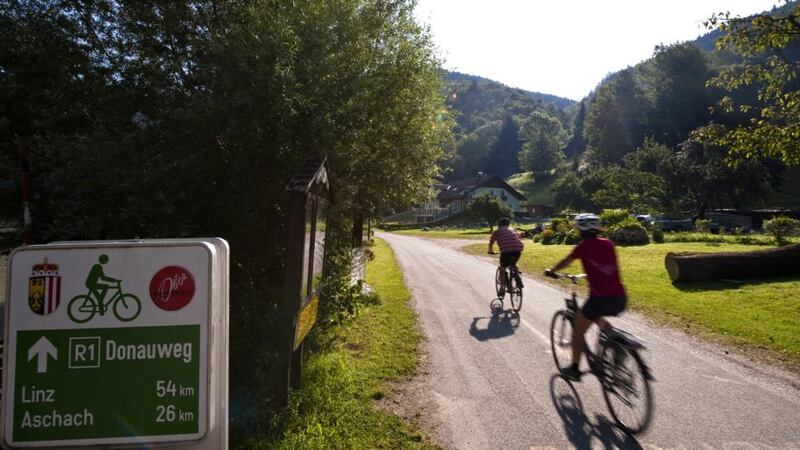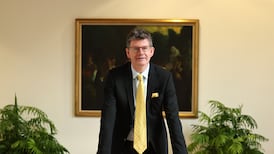The Danube rushed past my bedroom window, a foot below the sill, a set-up that had me sleeping beneath water level, immersed in nature in just one of many ways on this journey through four European countries.
We began in Passau, a German town where three rivers – the Danube, Inn and Ilz – come together. Our taxi driver proudly informed us that a million visitors flow into this place of confluence each year. As he delighted in listing the many visiting nationalities, we gazed out of the window down cobbled streets glimpsing ancient churches, art galleries (and, as we later found on a stroll, galleries in churches), umbrella-dotted waterside cafes and boats.
And there was ours, beside a circus on a peninsula pointing out of town; a long, three-deck river-cruiser – called My Story – bedecked in bicycles. They were lined up on the top deck and stacked beside the entrance ramp. As we went aboard, we found more: electric models huddling in halls out of rain's way.

We would not only be paddling down this river, visiting classical conurbations including Vienna, Budapest and Bratislava, but also spending days cycling along the Danube and into the countryside beside it, while the boat sailed on to meet us.
At just under 90 full cabins, it was a busy, cruisy scene, with tea and cakes on offer to get us settled. A man playing an electric organ damaged, frankly, such classics as Yesterday, but I accepted the twangy music as a cruise trope.
Our small sunken cabin was ingeniously designed to include a wardrobe, shower, basin and shelves, with one single bed permanently in place and another folded into the wall.
The boat set off for Engelhartszell as we went to dinner at a table of eight. We were joined by a Cork family, a British Brexit voter and an animated Aussie. Our fellow travellers in the packed dining room ranged in age from eight to 80 and were of all sizes, which just shows that cycling is for everyone when it’s along a flat surface, with power-assisted steeds for the more trepidatious.
There was no fat shaming here as, the following morning, most cyclists donned Lycra and displayed all the wonderful forms that humans come in.
The shaming comes my way for wearing a sun dress and flip-flops. “This is not standard gear,” says a German man, indicating my footwear to his wife but addressing me.
I’ve never been one to necessarily wear prescribed gear for certain activities, so explained to him that I want to feel the warm breeze on my legs and toes. We damp-Ireland dwellers need to be aired occasionally.
"You should say: 'There is nothing standard about me'," says the sassy young widow from Oz from our meal table, travelling around Europe for three months after bringing up children on her own. It's her time now: she's already caught the eye of a tour guide and, the previous week, titled European royalty on a yacht tour.
I felt the sartorially anticipated warm, tree-shaded air on my trainer-free feet as we cycled the Great Loop, or Donauschlinge, over 42km from Engelhartszell to Aschach on the first day. This is reputedly one of the most beautiful sections of the Danube, which, here at least, is not blue. “Taupe,” says sassy, although I’d call it milky-green in some stretches.
The Loop is indeed a stunner, as we discovered, gliding along the cycle path (radweg) between a dense-wooded hill and a river that forever bends out of sight into dark-green leafy valleys, looking fairytale enchanting page after page. Castles on hills add to the fairy story, many of them still inhabited. When the Habsburg Empire collapsed, it seems many of those Habsburgs held onto their substantial homes.
On the second day's cycle, from Devin to Bratislava, we pass the Schloss Hof (Imperial Palace), part of which is open to the public along with its formal gardens. It appears to be ample abode for anyone, but it turns out that this was just a hunting lodge for Prince Eugene, that served the Habsburgs, to "relieve the soul from the burden of ruling" (as it says on the gate). Gosh, how the ruling classes suffer.
Rolling through nature grounds you in earth’s scents: balmy blackberry bushes, bosky leaves, decaying wood, juicy water and earth, with freshly dug water channels throwing extra aromatic treats in sections. The cycling becomes meditative and you even forget you’re pedaling as you talk. The heady, hearty scenery distracts eyes, noses and ears while the legs do the rounds.
To get to Devin on day two, the boat slipped overnight practically the whole way across the top of Austria, past Vienna (it was going to stop there on the way back) and close to Bratislava, to which we were going to cycle on a circuitous route across 43km beneath beating sun.
En route we shaded in the Forsthaus restaurant below trees with hens clucking round our feet. Then we skirted the former Iron Curtain along a long road into Bratislava, weary but determined to walk from the moored ship into the town centre. We were rewarded with car-free cobbled streets, and drinks and cake in a huge square filled with tourists and classical music.
The drinking in squares and perusing antique shops continued on the day of “rest” in Budapest (with the option of cycling 53km to the artists’ town of Szentendre).
That third day had begun with me lying in bed watching majestic buildings floating past the window (my room-mate having a morning cigarette on the top deck), as we cruised into Budapest. Here is a beautiful and surreal slide show of architectural history – Gothic revival, Renaissance, Ottoman, Baroque, Classical. The boat stopped right in the city centre, opposite the vast parliament building (itself quite the combo: mainly neo-Gothic, but with touches of Renaissance and Baroque).
If I’d been less touristically inclined, I could have spent a capital day reading a book up on deck in this heroic central European spot. (We might call this eastern Europe, but all around these parts they correct such slack geographical nomenclature to “central Europe”.)
Sadly, due to issues back home we had to leave the trip here, flying out of Budapest that evening. We were sad to miss out on a day cycling the Danube Bend to Esztergom (43km), a day in Vienna and a final day cycling 37km from Krems to Melk before the boat returned to its start-point in Passau.
It had been a brilliant mix: of bike, boat, cities, villages and remote countryside – doing, sailing, seeing, experiencing. A sensory and geographical immersion.
Emma Cullinan travelled with Freedom Treks on the Danube River – 4 Countries – cycling tour, covering Germany, Austria, Slovakia and Hungary.











